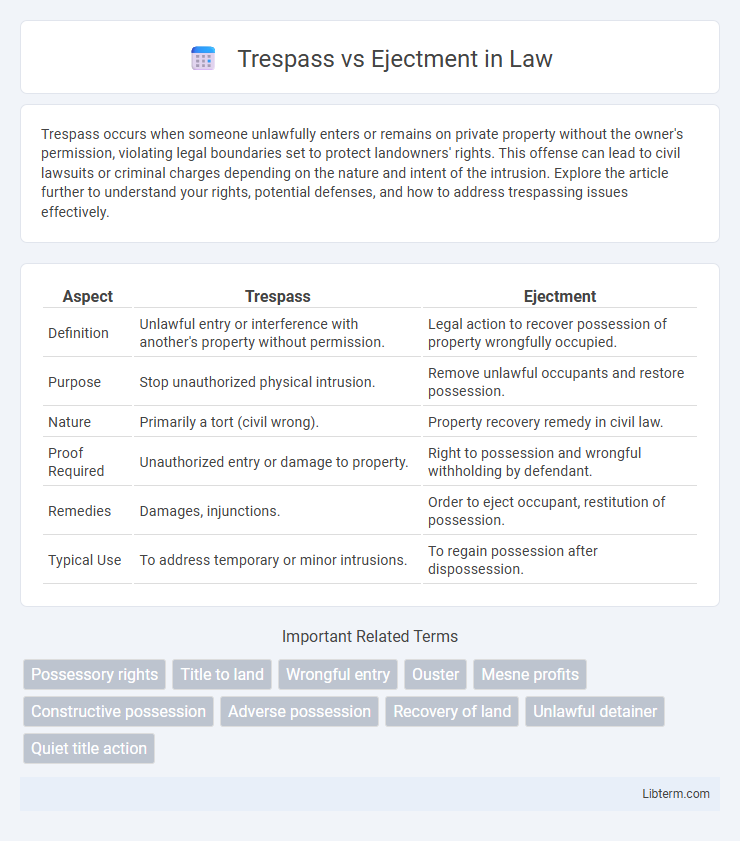Trespass occurs when someone unlawfully enters or remains on private property without the owner's permission, violating legal boundaries set to protect landowners' rights. This offense can lead to civil lawsuits or criminal charges depending on the nature and intent of the intrusion. Explore the article further to understand your rights, potential defenses, and how to address trespassing issues effectively.
Table of Comparison
| Aspect | Trespass | Ejectment |
|---|---|---|
| Definition | Unlawful entry or interference with another's property without permission. | Legal action to recover possession of property wrongfully occupied. |
| Purpose | Stop unauthorized physical intrusion. | Remove unlawful occupants and restore possession. |
| Nature | Primarily a tort (civil wrong). | Property recovery remedy in civil law. |
| Proof Required | Unauthorized entry or damage to property. | Right to possession and wrongful withholding by defendant. |
| Remedies | Damages, injunctions. | Order to eject occupant, restitution of possession. |
| Typical Use | To address temporary or minor intrusions. | To regain possession after dispossession. |
Overview of Trespass and Ejectment
Trespass involves unauthorized physical intrusion onto another person's property, causing harm or disturbance to the possessor's use and enjoyment of land. Ejectment is a legal action aimed at recovering possession of real property wrongfully occupied by another party, focusing on the claimant's right to exclusive possession. Both address property disputes but differ in purpose: trespass remedies immediate unlawful entry, while ejectment resolves disputes over rightful possession.
Legal Definitions: Trespass vs Ejectment
Trespass involves the unlawful entry onto another person's property without permission, emphasizing unauthorized physical presence or intrusion. Ejectment refers to a legal action initiated by a rightful property owner or occupant to recover possession and remove an individual unlawfully occupying or withholding possession of the property. Understanding these distinctions is crucial for property rights enforcement and determining appropriate legal remedies in real estate disputes.
Historical Development of Both Actions
Trespass originated in medieval English common law as a swift remedy for direct and forcible injuries to property or person, emphasizing immediate redress. Ejectment developed later as a specialized action to recover possession of land, evolving from fictitious legal forms to address disputes over title and possession more comprehensively. Both actions reflect the historical progression from simple, direct remedies to more complex, title-based property claims in common law.
Key Differences Between Trespass and Ejectment
Trespass involves the unauthorized entry onto someone's property, typically addressed through a civil lawsuit for damages or injunctions, emphasizing the unlawful presence itself. Ejectment is a legal action to recover possession of real property wrongfully held by another party, focusing on restoring rightful ownership or possession rather than simply penalizing intrusion. The key difference lies in trespass addressing initial unlawful entry, while ejectment seeks removal of an occupant to assert or reclaim property rights.
Elements Required to Prove Trespass
Trespass requires proof of an intentional entry onto another's property without permission, establishing unauthorized physical intrusion. The plaintiff must demonstrate actual possession of the property and that the defendant's entry was direct and forcible. Proving damages is not necessary, as the unauthorized entry itself constitutes the tort of trespass.
Elements Required to Prove Ejectment
To prove ejectment, the plaintiff must establish rightful possession or ownership of the property, demonstrate that the defendant is unlawfully withholding possession, and provide evidence of a demand for possession that the defendant refuses to comply with. The plaintiff must show a clear title or legal right to possess the property, supported by deeds or lease agreements, alongside proof of actual possession before the wrongful withholding by the defendant occurred. Courts require these elements to distinguish ejectment from trespass, which focuses primarily on unauthorized entry rather than unlawful possession.
Common Legal Scenarios for Trespass
Trespass commonly occurs in scenarios such as unauthorized entry onto private property, unlawful use of land for recreational purposes without permission, and intrusion by trespassing animals or vehicles. Property owners frequently address instances where individuals cross boundary lines or enter fenced areas without consent, leading to disputes resolved through legal actions. These cases often involve claims for damages or injunctions to prevent further unauthorized access.
Typical Cases Involving Ejectment
Typical cases involving ejectment often include disputes over the rightful possession of real property, such as when a tenant refuses to vacate after lease termination or when a party unlawfully occupies land without permission. Ejectment actions seek to recover possession and may require proving ownership or a superior right to possession, distinguishing them from trespass claims that address wrongful entry without necessarily resolving ownership issues. Courts frequently handle ejectment cases during landlord-tenant conflicts, boundary disputes, and situations involving adverse possession claims.
Remedies and Damages: Trespass vs Ejectment
Trespass remedies primarily involve compensatory damages for unauthorized entry or injury to property, aiming to restore the plaintiff to their original position, including nominal damages if no substantial harm occurred. Ejectment focuses on recovering possession of real property wrongfully withheld, with damages often covering lost rents or profits during the wrongful occupation. Courts may grant injunctive relief in ejectment cases to prevent continued wrongful possession, whereas trespass suits usually emphasize monetary compensation.
Practical Considerations for Property Owners
Property owners facing trespass should prioritize swift documentation and legal notices to establish clear evidence of unauthorized entry, while ejectment actions require comprehensive title records to prove rightful ownership and demand removal of occupants. Practical steps include hiring surveyors for boundary verification and engaging experienced real estate attorneys to navigate complex court procedures efficiently. Understanding local statutes for trespass and ejectment ensures property owners choose the most effective legal remedy to protect and regain possession.
Trespass Infographic

 libterm.com
libterm.com